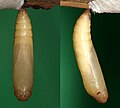Baracus vittatus
| Hedge-hopper | |
|---|---|

| |
| From Kozhikode, Kerala | |
| Scientific classification | |
| Domain: | Eukaryota |
| Kingdom: | Animalia |
| Phylum: | Arthropoda |
| Class: | Insecta |
| Order: | Lepidoptera |
| Family: | Hesperiidae |
| Genus: | Baracus |
| Species: | B. vittatus
|
| Binomial name | |
| Baracus vittatus (Felder, 1862)
| |
Baracus vittatus, the hedge-hopper, is a butterfly belonging to the family Hesperiidae. It is found in India and Sri Lanka.[1][2][3][4][5][6][7][8]
Description
[edit]In 1891, Edward Yerbury Watson described this butterfly as:
Male and female. Upperside dark olive-brown. Male with the lower basal and discal area of both wings olive-grey, and a small subapical spot of the same colour also on the forewing. Female: forewing with a small olive -grey subapical spot and slender macular discal streak: hindwing with less distinct olive-grey lower basal and discal area. Underside ferruginous, the veins narrowly lined with paler ferruginous: forewing with the basal area dusky brown: hindwing with a longitudinal medial yellow fascia from base of cell, and less distinct short yellow discal streak between the veins. Body, palpi, and legs olive-brown, paler beneath.
Subspecies
[edit]- B. v. vittatus (Felder, 1862) Sri Lanka
- B. v. subditus Moore, [1884] south India
- B. v. septentrionum Wood-Mason & de Nicéville, [1887] Sikkim to northeast India
- B. v. hampsoni Elwes & Edwards, 1897 (Hampson's hedge hopper)[2] south India
- B. v. gotha Evans, 1949 Tamil Nadu[6][7]
Life history
[edit]The larvae feed on Gramineae.[10]
-
Larva
-
Chrysalis
-
Chrysalis
-
Imago (dorsal view)
-
Imago (ventral view)
See also
[edit]References
[edit]- ^ Gamage, R. 2014. An Illustrated Field Guide to the Fauna of Sri Lanka, Butterflies. Akalanka Dunwathta. Baddegama
- ^ a b Savela, Markku. "Baracus vittatus (Felder, 1862)". Lepidoptera and Some Other Life Forms. Retrieved June 30, 2018.
- ^ Moore, Frederic (1880). The Lepidoptera of Ceylon. London: L. Reeve & co. p. 162.
- ^ Elwes & Edwards (1897). Transactions of the Zoological Society of London. London: Zoological Society of London. pp. 169–171.
- ^ Moore, Frederic (1884). Proceedings of the Zoological Society of London. London: Zoological Society of London. p. 534.
- ^ a b W. H., Evans (1949). A Catalogue of the Hesperiidae from Europe, Asia, and Australia in the British Museum. London: British Museum (Natural History). Department of Entomology. pp. 237–238.
- ^ a b Varshney, R.; Smetacek, P. A Synoptic Catalogue of the Butterflies of India (2015 ed.). New Delhi: Butterfly Research Centre, Bhimtal and Indinov Publishing. pp. 40–41.
- ^
 One or more of the preceding sentences incorporates text from this source, which is in the public domain: Swinhoe, Charles (1912–1913). Lepidoptera Indica. Vol. X. London: Lovell Reeve and Co. pp. 130–133.
One or more of the preceding sentences incorporates text from this source, which is in the public domain: Swinhoe, Charles (1912–1913). Lepidoptera Indica. Vol. X. London: Lovell Reeve and Co. pp. 130–133.
- ^ E. Y., Watson (1891). Hesperiidae Indicae: being a reprint of descriptions of the Hesperiidae of India, Burma, and Ceylon. Madras: Vest and Company. p. 151.
- ^ Robinson, G. S., P. R. Ackery, I. J. Kitching, G. W. Beccaloni & L. M. Hernández, 2010. HOSTS - A Database of the World's Lepidopteran Hostplants. Natural History Museum, London. nhm hosts





